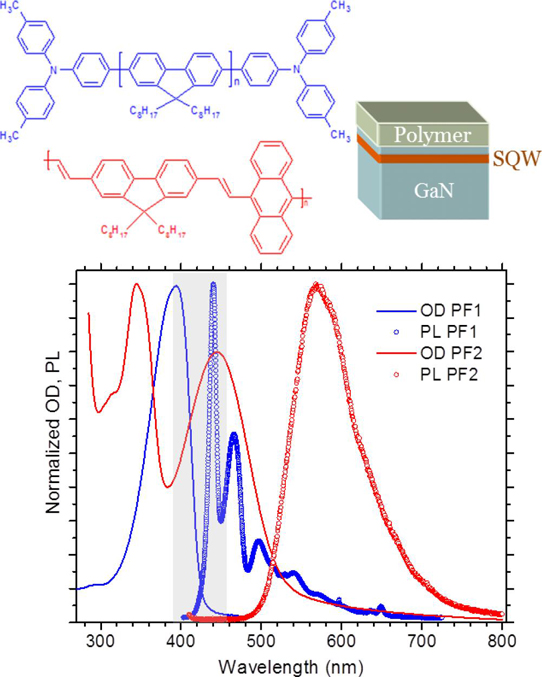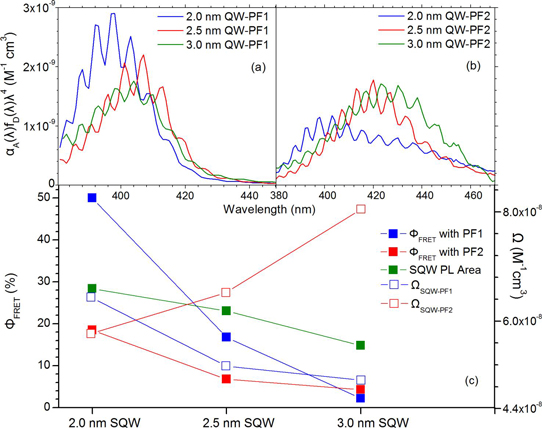- News
15 December 2015
Exploring resonant energy transfer from InGaN wells to polymers
University of Cyprus, Cyprus University of Technology, and University of Crete have been exploring the potential of Förster resonant energy transfer (FRET) from an indium gallium nitride (InGaN) single quantum well (SQW) to a light-emitting polymer layer [G. Itskos et al, J. Chem. Phys., vol143, p214701, 2015].
Rather than the usual transfer of energy and charge in electronic systems, FRET just transfers energy, potentially avoiding losses associated with charge transport and recombination. Such losses can be particularly severe at interfaces between materials.
FRET depends on dipole-dipole coupling between two light-sensitive materials ('chromophores') with non-radiative energy transfer from a donor to an acceptor. Since the dipole-dipole interaction is short range, the effect falls off rapidly with distance between the donor and acceptor. The effect is similar to near-field communication, except that it occurs at light rather than radio frequencies.
Proposals have been made and demonstrated for using the FRET effect in light-emitting and -harvesting devices.
Grigorios Itskos, primary researcher and assistant professor at the University of Cyprus, comments: "The outcome of our investigation can guide future efforts towards a rational design of hybrid geometries that can optimize FRET and limit competing losses to render FRET-based devices feasible."
While InGaN is already used for commercial light-emitting diodes (LEDs), Itskos believes that the functionality of such devices could be further increased by combining them with soft semiconductors such as light-emitting polymers. "The spectral tunability and high light-absorption and emitting efficiency of the polymers can be exploited to demonstrate efficient down-conversion of the blue nitride emission, providing a scheme for efficient hybrid LEDs," Itskos says.
The InGaN quantum well structures were grown on c-plane sapphire with GaN template layer using radio frequency molecular beam epitaxy (RF-MBE). The InGaN well was sandwiched between a 0.5μm GaN buffer and a cap layer. The cap consisted of gallium nitride or aluminium gallium nitride (AlGaN).

Figure 1: Normalized absorbance (solid) and PL (scatter) excited at 350nm of ∼10nm-thick films of polyfluorenes PF1 (blue) and PF2 (red), employed to complete the hybrid structures. Gray highlighted area indicates PL spectral range of inorganic (Ga,In)N SQWs hybrid component.
Polyfluorene homo- or co-polymers (Figure 1) were spin-coated in solution onto the heterostructures. The homopolymer (PF1) was poly(9,9-dioctyfluorenyl-2,7-diyl) end-capped with N,N-bis (4-methylphenyl)-aniline, typically known as PFO. The copolymer (PF2) was poly[(9,9-dioctyl-2,7-divinylenefluorenylene)-alt-co-(9,10-anthracene)]
The team used steady-state photoluminescence (PL), photoluminescence excitation (PLE), and time-resolved PL (TR-PL) to study the influence on FRET of SQW width (Figure 2), InN mole fraction, and growth temperature, along with top cap thickness, content, growth temperature, and n-doping. The researchers comment: "To our knowledge, no studies where the influence of doping on FRET has been explicitly examined have been reported to date."

Figure 2: (a, b) Products of area-normalized emission of three SQWs with different well widths with molar absorptivity αA as a function of wavelength (λ) of PF1, PF2, respectively. (c) FRET efficiency (blue, red solid symbols), spectral overlap (Ω) (blue, red hollow symbols) and QW PL integrated area (green solid symbols) for hybrid structures based on PF1, PF2, and three SQWs.
Simulations suggested that n-type doping of the cap would shift the electron wavefunction more to the center of the QW, improving overlap with the hole wavefunction that was little affected in position. Increased overlap should lead to increased light emission in photoluminescence or an increased efficiency of FRET coupling with the polymer layers. However, the experimental results showed a detrimental effect of doping on PL efficiency, in contradiction to the simulation model.
Itskos comments: "This constitutes a potential limitation for the implementation of such hybrid structures in real-world electronic devices, as electronic doping is required to produce efficient practical devices. Further studies are needed to establish the exact influence of doping on FRET."
The researchers write: "It is quite possible that doping in such a close proximity to the emission layer leads to dopant diffusion into the well and collisional exciton recombination affecting the QW PL quantum yield. A reduction of the SQW emission yield would then strongly influence the FRET process."
The team found three significant loss mechanisms that compete with FRET. The first loss came from recombination of SQW excitations at the interface with, or hole transfer to, the organic material. "This effect appears more intense in hybrids containing high Al content that appears to promote hole localization at the barrier," the researchers report.
The second loss was from back transfer of carriers and/or interfacial quenching subsequent to energy transfer to the organic acceptor. The final loss route was through quenching of SQW emission and FRET efficiency in the presence of an n-doped nitride interlayer, as discussed above.
According to Itskos, the studies indicate a strong link between the quantum well's luminescence and the hybrid structure's FRET efficiency. This correlation could allow optimizing the luminescent efficiency of the energy donor without the acceptor material layer, before creating an efficient hybrid FRET.
The team plans to perform a systematic study of hybrid structures based on doped nitride quantum wells to investigate the mechanisms via which electronic doping affects the FRET characteristics.
http://dx.doi.org/10.1063/1.4935963
The author Mike Cooke is a freelance technology journalist who has worked in the semiconductor and advanced technology sectors since 1997.


